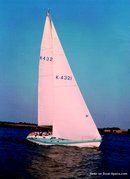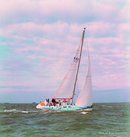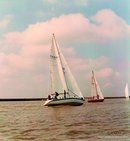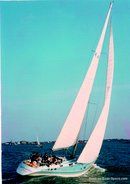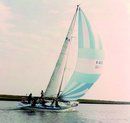Oyster SJ43 Mast head rigging
Sailboat specifications
The Oyster SJ43 is a 43’5” (13.22m) cruiser-racer sailboat designed by Stephen Jones Yacht Design (United Kingdom). She was built between 1981 and 1985 by Oyster (United Kingdom). The Mast head rigging version is offered with a classic masthead Marconi sloop rig.
The Oyster SJ43 is as well listed, on Boat-Specs.com, in Fractional rigging version (see all the versions compared).
The Oyster SJ43 is as well listed, on Boat-Specs.com, in Fractional rigging version (see all the versions compared).
Oyster SJ43's main features
- Model
- Oyster SJ43
- Version
- Mast head rigging
- Hull type
- Monohull
- Category
- Offshore cruiser-racer sailboat
- Sailboat builder
- Sailboat designer
- Sailboat collection
- Country
- United Kingdom
- Construction
- Hull and deck: GRP (glass reinforced polyester)
- Number of hulls built
- About 10
- First built hull
- 1981
- Last built hull
- 1985
- Appendages
- Keel : fin without bulb
- Helm
- Single helm wheel
- Rudder
- Single spade rudder
- Unsinkable
- No
- Trailerable
- No
- Standard public price ex. VAT (indicative only)
- N/A €
Oyster SJ43's main dimensions
- Hull length
- 43’ 5”13.22 m
- Waterline length
- 34’10.36 m
- Beam (width)
- 14’ 1”4.29 m
- Draft
- 7’ 5”2.25 m
- Light displacement (MLC)
- 18453 lb8370 kg
- Ballast weight
- 8311 lb3770 kg
- Ballast type
- Lead
Oyster SJ43's rig and sails
- Upwind sail area
- 829 ft²77 m²
- Rigging type
- Sloop Marconi masthead
- Rotating spars
- No
- Number of levels of spreaders
- 2
- Spreaders angle
- 0 °
- Spars construction
- Aluminum spars
- Standing rigging
- 1x19 strand wire
Oyster SJ43's performances
- Upwind sail area to displacementiThe ratio sail area to displacement is obtained by dividing the sail area by the boat's displaced volume to the power two-thirds.
The ratio sail area to displacement can be used to compare the relative sail plan of different sailboats no matter what their size.
Upwind: under 18 the ratio indicates a cruise oriented sailboat with limited performances especially in light wind, while over 25 it indicates a fast sailboat. - 201 ft²/T18.68 m²/T
- Displacement-length ratio (DLR)iThe Displacement Length Ratio (DLR) is a figure that points out the boat's weight compared to its waterline length. The DLR is obtained by dividing the boat's displacement in tons by the cube of one one-hundredth of the waterline length (in feet).
The DLR can be used to compare the relative mass of different sailboats no matter what their length:
a DLR less than 180 is indicative of a really light sailboat (race boat made for planning), while a DLR greater than 300 is indicative of a heavy cruising sailboat. - 213
- Ballast ratioiThe Ballast ratio is an indicator of stability; it is obtained by dividing the boat's displacement by the mass of the ballast. Since the stability depends also of the hull shapes and the position of the center of gravity, only the boats with similar ballast arrangements and hull shapes should be compared.
The higher the ballast ratio is, the greater is the stability. - 45 %
- Critical hull speediAs a ship moves in the water, it creates standing waves that oppose its movement. This effect increases dramatically the resistance when the boat reaches a speed-length ratio (speed-length ratio is the ratio between the speed in knots and the square root of the waterline length in feet) of about 1.2 (corresponding to a Froude Number of 0.35) . This very sharp rise in resistance, between speed-length ratio of 1.2 to 1.5, is insurmountable for heavy sailboats and so becomes an apparent barrier. This leads to the concept of "hull speed".
The hull speed is obtained by multiplying the square root of the waterline length (in feet) by 1.34. - 7.81 knots
Oyster SJ43's auxiliary engine
- Engine(s)
- 1 inboard engine
- Fuel type
- Diesel
Oyster SJ43's accommodations and layout
- Cockpit
- Closed aft cockpit
- Cabin(s)
- 2
- Berth(s) (min./max.)
- 6 / 10
- Head(s)
- 2
Similar sailboats that may interest you:
Sailboats
First built hull
Hull length
2007
44’ 11”13.68 m
1990
45’ 7”13.9 m
1988
44’ 1”13.44 m
1980
39’ 8”12.09 m
1981
43’ 5”13.22 m
1981
41’ 11”12.77 m
1981
41’ 4”12.6 m
1981
41’ 11”12.77 m
1980
42’12.8 m
1984
44’13.4 m
1982
45’ 10”13.95 m
1978
44’ 5”13.54 m
1996
40’ 10”12.45 m
1990
40’ 2”12.25 m
1985
40’ 2”12.25 m

